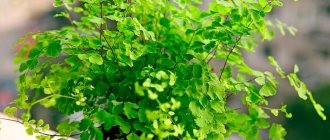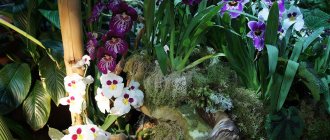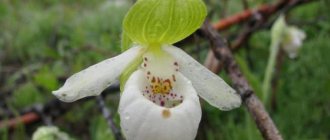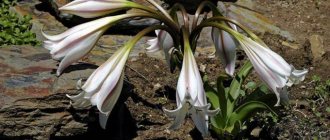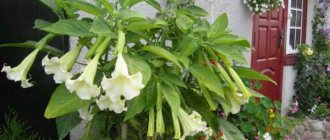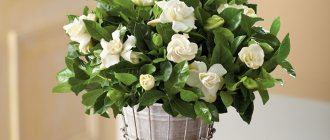The size of the plant can reach 60 cm, its growth rate is low.
Lady's slipper (another name for paphiopedilum) is a perennial plant; modern hybrids can bloom several times a year. Among them, single- and multi-flowered, as well as revolving flower specimens are most often found. The most popular shades of flowers are red, green and yellow.
| Low growth rate. |
| Paphiopedilums with monochromatic leaves bloom in late winter, variegated forms bloom in summer-autumn. |
| Paphiopedilum is easy to grow, but you need to follow the rules. |
| Perennial. |
Origin and name
Natural species grow in the tropical, monsoon and subtropical climate of Southeast Asia in China, India, Nepal and Oceania. The name Paphiopedilum literally translates as “slipper from Paphos,” the hometown of Venus.
A beautiful legend has been preserved about the plant - the beautiful goddess was in such a hurry to retire in the forest with her beloved Adonis that she lost her golden slipper. A commoner hunter discovered the loss, bent down to pick it up, and it suddenly became a flower, graceful and unusually beautiful. The appearance of the Venus slipper truly fascinates with its grace and tenderness.
Lady's slipper description, or what paphiopedilum looks like
The roots of a healthy plant are brownish and covered with small fibers, the tips are white during the period of active development. A shortened stem grows from the rhizome, on which a rosette of strap-shaped or broad-linear leaves, rich green, and in some species with a marble pattern, is formed as a symmetrical double-sided fan.
Each rosette blooms only once, forming a peduncle from 4 to 60 cm long with one shoe, with the exception of the Victoria-regina species, which has up to 30 of them, but opening alternately. The flowers of the lady's slipper in most species are large, bright, in red-yellow-greenish shades, especially the lip, which attracts pollinating insects with its striking color and sweetish nectar on the inner walls.
Possible problems in growing
In general, Cyprediums are disease resistant, but are sometimes attacked by pests such as mealyworms or mites.
Drops buds and leaves
Buds may fall off for the following reasons:
- insufficient lighting;
- a lot or little water;
- dry air;
- exposure to a draft;
- temperature changes;
- diseases or pests.
Fallen buds are a sad sight
The leaves are turning pale
Foliage may lose color and become limp due to flooded roots.
The tips of the leaves are drying out
If a flower is constantly exposed to direct sunlight, its leaves may dry out or turn yellow.
The lower leaves fall off
Leaves from the bottom of the stem may fall off if maintenance conditions are violated: improper watering, poor lighting, overheating and incorrect feeding.
Growing lady's slipper orchid
Among Paphiopedilums, epiphytic species are rare. In nature, representatives of the genus grow, as a rule, in the litter of tropical forests or as lithophytes - in rock crevices on humus carried by the wind and washed up by sediments. Therefore, when kept indoors, the plant needs to create conditions that are as close as possible to its natural habitat.
Planting paphiopedilum: basic tips
To grow lady's slipper, select an opaque plastic or ceramic pot that is proportional to the root system. Transparent containers are also used, but only to monitor the condition of the roots and lower layers of the substrate.
The plant is replanted annually if it is young, or every 2–3 years when one of the reasons is present:
- 8–10 or more rosettes have formed in the pot;
- a new shoot grew and became stronger, and a desire arose to divide;
- after flowering is completed;
- the degree of salinity and decomposition of the substrate affects the general condition of the plant;
- in almost any of the above reasons - in the spring.
Some orchid growers partially replace the soil in the pot after every 6-8 months.
Substrate composition
The substrates for paphiopedilums are based on pine bark and peat soil for seedlings in a 3:1 ratio. As additional ingredients, gardeners use small quantities of charcoal, coarse river sand, perlite or expanded clay, coconut shavings instead of bark, and sphagnum moss to retain moisture. The pH of the substrate for most paphiopedilums is preferably neutral or slightly acidic, with the exception of calceophiles, which are accustomed to growing in nature on limestone rocks.
Soil selection and fertilizing
The main requirement for soil for the Paphiopedilum orchid is that it must retain moisture well. Often the soil may include pine bark, sphagnum moss and charcoal. The soil should be fairly light and fluffy.
Feeding orchids should be done at least once a month, and during the flowering period it is recommended to carry out this procedure twice. You can use mineral fertilizers specially designed for this, but it is better to halve the recommended proportions. "Paphiopedilum" does not tolerate excess salts in the soil. In order to avoid this, you can water the flower with distilled water, and next time add mineral fertilizers.
Caring for a lady's slipper orchid
The Paphiopedilum orchid, caring for which at home requires the daily presence of a grower and constant monitoring of its condition, is considered a rather whimsical and capricious flower.
Placement in the house, lighting and temperature conditions: what is important to remember
A suitable location for paphiopedilum is the window sills of north-eastern, north-western, eastern and western windows, although some species also successfully develop in northern exposure. The room where the plant is kept is often ventilated, and in the summer it is moved to the garden.
The lady's slipper flower prefers diffused light, but at the same time can withstand slight shading. The plant cannot be called shade-loving.
Flower growers have different opinions regarding the temperature preferences of paphiopedilum, but many still argue that, conventionally, lady’s slippers are divided into those that require moderate maintenance at temperatures of 18–22 degrees and heat-loving ones, for which a comfortable temperature regime is 25–30 degrees and above. General recommendations are 18–25 degrees in summer and permissible short-term decreases in the off-season are not lower than 10 degrees and in hot weather up to 33. A pronounced resting period is not observed in paphiopedilums.
Watering and ambient humidity
During the active growing season, the lady's slipper plant is watered regularly and abundantly, however, it is imperative to briefly dry the substrate. The flower is very afraid of stagnation of water and is easily attacked by fungi, so the key to caring for it is correct balanced watering, which instantly changes with any deviations in the microclimate of the room.
Droplets of moisture that fall inside the outlet during watering - the place most vulnerable to rot - are immediately blotted off with a dry paper napkin. The same procedure is carefully carried out after a warm shower.
The ambient humidity for the shoe is preferably in the range from 60 to 80%. They increase it in a way convenient for gardeners - with special devices or by arranging an indoor fountain, lay sphagnum moss on top of the substrate without touching the root collar, and spray it twice a day with a spray bottle, and also place flower containers on a tray with wet pebbles or expanded clay.
Feeding
Lady's slipper reacts painfully to excess fertilizer, so feed it no more than 2 times a month, alternating organic and mineral fertilizers for orchids, but diluting it in half the dose. Fertilizing is done during the growing season; after flowering, the plant rests and practically does not need nutrients.
Temperature and lighting
The optimal summer temperatures for the Paphiopedilum orchid are plus 23-28 degrees, and in winter the temperature can fluctuate between plus 18-23 degrees. For cold-resistant varieties with wide and dark leaves, these figures may be slightly lower. However, it is necessary to constantly remember that the temperature at night should always be 3-5 degrees lower than during the day. When the temperature drops to +4 degrees and below, the plants die.
As for light, Paphiopedilum orchids are quite shade-tolerant, but feel best in good diffused light. Direct sunlight is poorly tolerated. In order for flowering to proceed normally in winter, it is recommended to install special lamps to provide additional lighting.
How to care for a lady's slipper during flowering
The formation of buds in most indoor lady's slippers occurs in late autumn or early winter. With proper care and maintenance, the plant grows a new flowering rosette every year. A sign of readiness for flowering is the appearance of a so-called signal stop leaf in the center of the rosette, small and tight, from the flaps of which the top of the peduncle with a bud will soon appear.
However, this does not always mean that paphiopedilum will bloom. If there were no mistakes in the care of the previous year, the slipper will delight the orchid grower with a miracle flower, otherwise the stop list will remain empty, but there is no need to be completely upset - there is a high probability of the formation of a new rosette.
Attention! During the formation of a bud, it is not recommended to disturb the plant - move it to another place, rotate the pot around its axis. You shouldn’t change anything in your care at all!
At the end of flowering, the shoe needs rest. During this time, the ambient temperature drops to 15–20 degrees, watering is reduced and almost no fertilizing is done. Only after new growth has “pecked” on the old rosette is the previous care resumed.
Transfer
The reason for replanting an orchid may be wear and tear of the soil or an increase in the size of the plant. This procedure is carried out on average once every two years. Before transplanting, about a day before, you need to soak the flowerpot well.
Replanting a Paphiopedilum orchid
The pre-soaked plant is carefully removed from the pot; this is done with special care if the orchid grew in a clay pot, because the roots often grow to its walls.
The roots are cleaned of old substrate and damaged areas. Drainage is poured into the bottom of the pot, the substrate is poured in gradually and compacted a little. The flower is not planted deep, but not too high to the surface of the soil. After transplantation, the plant is not watered for about a week so that rot does not appear on the damaged areas of the roots. The orchid pot is placed away from sunlight and kept at normal temperature. After some time (about three weeks), when the flower takes root, it is transferred to its usual location and standard care is followed.
Video about transplanting Paphiopedilum
Reproduction of Paphiopedilum at home
In indoor culture, slippers are propagated by dividing the bush. The seed method is used in greenhouse conditions, observing the requirements of absolute sterility. However, Paphiopedilum varieties can only be propagated by vegetative propagation.
The bushes are divided during transplantation if there are more than 8–10 rosettes in the pot. The rhizome is dissected in such a way that at least 3 rosettes remain on each section.
You often come across advertisements for the sale of shoes with 1 or 2 sockets. Orchid growers with 20 years of experience claim that such divisions have no more than a 40% chance of survival, and only in very rare cases with the most ideal care. The probability of plants blooming this year and next year is zero. In the best case, if the shoe survives, it will grow a new rosette no earlier than 2–3 years, while it survives the stress of dividing the rhizome.
Buying a seedling and growing it to an adult specimen is sometimes easier than coming out of a shoe after an unsuccessful division of the rhizome. However, paphiopedilum grown from seeds will bloom in 5 or 6 years.
Pests and diseases of slippers
The Paphiopedilum orchid has extremely sensitive leaves and root systems. Dying of leaf blades is often observed. There are several reasons depending on the symptoms of this process:
- the leaf first turns yellow, then turns brown - a natural phenomenon;
- the top of the leaf becomes dark brown, almost black, then the whole brown edge creeps along the edge of the leaf plate, tapering towards the central vein - the plant is overfed or infected with the fungus Glomerella cingulata, the causative agent of anthracnose.
The fall of flowers that have not fully bloomed is caused by the mold fungus botrytis. Light brown spots initially appear on the petals and lip. The reason is a decrease in night temperature in a room with high air humidity.
As a result of waterlogging, the root system of slippers is affected by fungi that cause fusarium, rhizoctonia, late blight, and pythium.
Among the insect pests on lady's slippers, the most commonly noticed are flat beetle mites, or false spider mites, mealybugs and scale insects.
Paphiopedilum species
There are up to 80 species in the genus Paphiopedilum, but their number is constantly changing. The number of natural and artificial hybrids is also changeable; more than a thousand of them have been created. The most famous species in indoor and greenhouse floriculture:
The pretty one, or bellatulum, is native to Burma. The flowers are snow-white with crimson specks, about 8–10 cm in circumference, and appear in April. Leaves are spotted.
Paphiopedilum Bellatulum (Pretty)
Apricot is a very late discovered species, in 1982, with showy sunny yellow flowers with an orange throat and mottled foliage.
Paphiopedilum armeniacum (Apricot)
Adorable, or beautiful - originally from the Himalayas. It blooms at the end of winter with large single flowers about 15 cm in diameter. The lip is orange with greenish veins, the petals are in the same colors, dotted with distinct longitudinal stripes.
Paphiopedilum venustum (Lovely)
Snow-white - has a pleasant aroma. Leaves in marble patterns. The flowers are pure white, shining, no more than 8 cm in circumference, bloom in summer. It is extremely gentle, heat-loving and requires much less fertilizer than other species.
Paphiopedilum niveum (Snow White)
Lawrence is home to the island of Borneo. Luxurious appearance with a gorgeous flower 9–13 cm in circumference. The sail is white with longitudinal purple veins, the lip is cherry red. Blooms in spring.
Paphiopedilum lawrenceanum (Lawrence)
Rough-haired - Indian species, blooms for a long time from autumn to early or mid-spring. The upper petal is burgundy-brown, the edge is greenish-white, the side petals are ocher-chocolate in color, the lip is pale brown with reddish stains.
Paphiopedilum hirsutissimum (Rough-haired)
Single-color, or concolor, is common in southwestern China, southeastern Thailand, Burma, Cambodia and Laos. The flower is up to 5.5–7 cm in diameter, cream or yellowish, less often white or ecru, strewn with small purple peas.
Paphiopedilum concolor (Monocolor)
Wonderful - Himalayan species, blooms from September to February with greenish fragrant flowers.
paphiopedilum insigne (Wonderful)
The bearded one is the parent of the first artificial hybrid; it began to be grown in culture earlier than other natural species. The foliage has an expressive marble pattern, the flowers are painted in red-purple tones: the sail is in burgundy stripes on a white background, the lip and side petals are dark scarlet. Blooms in spring.
Paphiopedilum barbatum (Bearded)
Appletona is a large spring-blooming orchid with spotted leaves and a greenish-purple flower up to 10 cm in circumference, native to Southeast Asia.
Paphiopedilum appletonianum (Appleton's)
